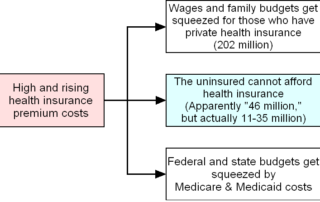By focusing only on covering the uninsured, are we solving the wrong problem?
The traditional Beltway logic on health care reform goes like this:
- The problem is that 46 million Americans lack health insurance. (I addressed why this number is incorrect and misleading last Thursday.)
- Government should provide health insurance to those 46 million people, or at least pay for it.
- Let’s expand a taxpayer-subsidized health insurance program to cover the 46 million, or maybe create a new program.
- (Alternately: Let’s mandate that everyone has to buy/have health insurance.)
- This means everyone will have health insurance. We have solved the problem.
Much of the health policy debate centers on how to solve this problem. Liberals want to expand government programs: Medcaid, S-CHIP, Medicare, or the federal employee health benefit program (FEHBP). Conservatives argue that we should instead provide tax incentives to subsidize the purchase of private health insurance.
I fall in the latter camp. My preferred health reform includes taxpayer subsidies for the purchase of private health insurance. But before we jump into the argument about the solution, it is important that we define the problem correctly. Today I would like to challenge the premise that the goal of health reform should be only, or even primarily, to provide taxpayer-subsidized health insurance to those who are uninsured. That defines the problem too narrowly.
Here is my alternate logic:
- The problems are (a) health insurance is expensive, and (b) the cost of health insurance grows faster than compensation.
- These two factors (expensive and getting more so) mean that:
- Private health insurance gets more expensive each year for the 202 million Americans who have it. This directly squeezes wages when health insurance is provided by an employer, and household budgets no matter how it is purchased.
- Uninsured people cannot afford health insurance. Those who can just barely afford it this year risk losing it next year and becoming uninsured as their premiums grow faster than their wages.
- Public health insurance expenditures for Medicare, Medicaid, S-CHIP, and FEHBP roughly track private health insurance expenditures over time. High and rapidly-growing health insurance costs therefore crush federal and state government budgets.
- If we can figure out ways to make health insurance less expensive, and/or slow the growth of health insurance premiums, we will solve all three of […]
